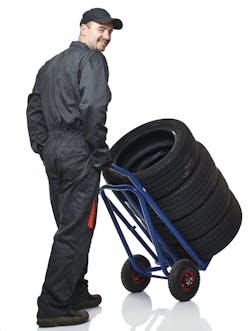The value of having a dedicated parts and service assistant, part 2
In my previous column – which appeared in the August issue, I noted the benefits that both fleet and service providers can reap by bringing onboard a dedicated parts and service assistant in their operation. Chief among the benefits are efficiency gains accrued by lessening the workload on technicians and keeping technicians where they are most needed: in the work bay.
A parts and service assistant would help maximize shop efficiency by taking on certain duties and tasks, such as taking requests for parts from technicians in the work bays and delivering parts, freeing up technicians to concentrate on repairs and service.
While the help such an assistant could provide to a shop may be clear, the challenge is often how a case can be made for creating this new position. Toward that end, TMC’s S.16 Service Provider Study Group created RP 1605, Justification for a Parts and Service Assistant.
This recommended practice (RP) focuses on four key areas: personnel, parts requisition forms, parts transporting and measurement. The first two topics were addressed in my August column. Parts transporting and measurement is the topic of this column.
Transporting Parts
As noted in RP 1605, to help a parts and service assistant make the best use of their time, a hand truck should be made available for them to deliver parts to the service bays. A rolling cart can be used to transport larger parts and materials.
Additionally, outfitting the cart with secure storage areas/devices provides space for small, fast moving items – such as, O-rings, seals, wire connectors, tie straps, etc. – and will enable the specialist to fill requests for miscellaneous items without additional trips to the warehouse or storage areas.
Measurement
Prior to bringing onboard a parts and service assistant, target areas of parts and service improvement should be benchmarked. The reason being is this will provide a clear understanding of progress once the assistant is hired and is assigned his or her duties and responsibilities.
- Parts department benchmarks – Considerations to measure progress within the parts department may include:
- Time duration between request and order filled.
- Warranty part and core charge-backs owing to no part returned.
- Special order parts returned to inventory.
- Inventory shortages.
- Total parts sold.
- Service department benchmarks – These are some measurements for the service department:
- Individual and total technician efficiency.
- Non-productive or idle time.
- Labor dollar-to-parts ratio.
Prior to implementation, managers should communicate company goals clearly to both parts and service personnel, soliciting and considering feedback from each team member. Once implemented, posting targeted metrics and continued team meetings will help further the success of a parts and service assistant.
One of Many
The specifications highlighted in this and the previous column form the backbone of RP 1605, Justification for a Parts and Service Assistant. It is just one of more than 450 TMC RPs that have been created for the purpose of improving maintenance efficiency and providing the industry with trucking solutions.
Kenneth Calhoun is the outgoing chairman of TMC’s S.16 Service Provider Study Group. In February 2015, he was elected to TMC’s board of directors as its first service provider representative. He is also vice president of customer relations for Truck Centers of Arkansas (www.truckcentersar.com), a full-service dealership with headquarters in North Little Rock, Ark. TMC is North America’s premier technical society for truck equipment technology and maintenance professionals (www.trucking.org/Technology_Council.aspx). It is a part of the American Trucking Associations (www.truckline.com), the largest national trade association for the trucking industry.
About the Author
Kenneth Calhoun
Technology & Maintenance Council (TMC)
Vice President, Customer Relations, Truck Centers of Arkansas; Service Provider Director at Large, Technology & Maintenance Council (TMC) Board of Directors; Immediate Past Chairman, TMC S.16 Service Provider Study Group
